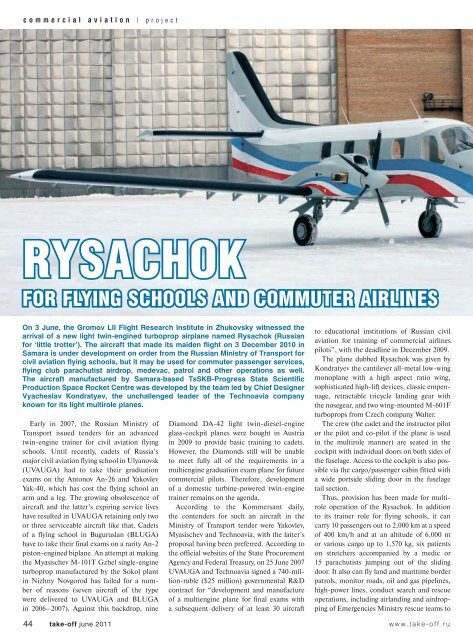SSJ100 launches operations PAK FA two prototypes flying already ...
SSJ100 launches operations PAK FA two prototypes flying already ...
SSJ100 launches operations PAK FA two prototypes flying already ...
You also want an ePaper? Increase the reach of your titles
YUMPU automatically turns print PDFs into web optimized ePapers that Google loves.
commercial aviation | project<br />
RYSACHOK<br />
FOR FLYING SCHOOLS AND COMMUTER AIRLINES<br />
On 3 June, the Gromov LII Flight Research Institute in Zhukovsky witnessed the<br />
arrival of a new light twin-engined turboprop airplane named Rysachok (Russian<br />
for ‘little trotter’). The aircraft that made its maiden flight on 3 December 2010 in<br />
Samara is under development on order from the Russian Ministry of Transport for<br />
civil aviation <strong>flying</strong> schools, but it may be used for commuter passenger services,<br />
<strong>flying</strong> club parachutist airdrop, medevac, patrol and other <strong>operations</strong> as well.<br />
The aircraft manufactured by Samara-based TsSKB-Progress State Scientific<br />
Production Space Rocket Centre was developed by the team led by Chief Designer<br />
Vyacheslav Kondratyev, the unchallenged leader of the Technoavia company<br />
known for its light multirole planes.<br />
Early in 2007, the Russian Ministry of<br />
Transport issued tenders for an advanced<br />
twin-engine trainer for civil aviation <strong>flying</strong><br />
schools. Until recently, cadets of Russia’s<br />
major civil aviation <strong>flying</strong> school in Ulyanovsk<br />
(UVAUGA) had to take their graduation<br />
exams on the Antonov An-26 and Yakovlev<br />
Yak-40, which has cost the <strong>flying</strong> school an<br />
arm and a leg. The growing obsolescence of<br />
aircraft and the latter’s expiring service lives<br />
have resulted in UVAUGA retaining only <strong>two</strong><br />
or three serviceable aircraft like that. Cadets<br />
of a <strong>flying</strong> school in Buguruslan (BLUGA)<br />
have to take their final exams on a rarity An-2<br />
piston-engined biplane. An attempt at making<br />
the Myasischev M-101T Gzhel single-engine<br />
turboprop manufactured by the Sokol plant<br />
in Nizhny Novgorod has failed for a number<br />
of reasons (seven aircraft of the type<br />
were delivered to UVAUGA and BLUGA<br />
in 2006–2007). Against this backdrop, nine<br />
44 take-off june 2011<br />
Diamond DA-42 light twin-diesel-engine<br />
glass-cockpit planes were bought in Austria<br />
in 2009 to provide basic training to cadets.<br />
However, the Diamonds still will be unable<br />
to meet fully all of the requirements in a<br />
multiengine graduation exam plane for future<br />
commercial pilots. Therefore, development<br />
of a domestic turbine-powered twin-engine<br />
trainer remains on the agenda.<br />
According to the Kommersant daily,<br />
the contenders for such an aircraft in the<br />
Ministry of Transport tender were Yakovlev,<br />
Myasischev and Technoavia, with the latter’s<br />
proposal having been preferred. According to<br />
the official websites of the State Procurement<br />
Agency and Federal Treasury, on 25 June 2007<br />
UVAUGA and Technoavia signed a 740-million-ruble<br />
($25 million) governmental R&D<br />
contract for “development and manufacture<br />
of a multiengine plane for final exams with<br />
a subsequent delivery of at least 30 aircraft<br />
to educational institutions of Russian civil<br />
aviation for training of commercial airlines<br />
pilots”, with the deadline in December 2009.<br />
The plane dubbed Rysachok was given by<br />
Kondratyev the cantilever all-metal low-wing<br />
monoplane with a high aspect ratio wing,<br />
sophisticated high-lift devices, classic empennage,<br />
retractable tricycle landing gear with<br />
the nosegear, and <strong>two</strong> wing-mounted M-601F<br />
turboprops from Czech company Walter.<br />
The crew (the cadet and the instructor pilot<br />
or the pilot and co-pilot if the plane is used<br />
in the multirole manner) are seated in the<br />
cockpit with individual doors on both sides of<br />
the fuselage. Access to the cockpit is also possible<br />
via the cargo/passenger cabin fitted with<br />
a wide portside sliding door in the fuselage<br />
tail section.<br />
Thus, provision has been made for multirole<br />
operation of the Rysachok. In addition<br />
to its trainer role for <strong>flying</strong> schools, it can<br />
carry 10 passengers out to 2,000 km at a speed<br />
of 400 km/h and at an altitude of 6,000 m<br />
or various cargo up to 1,570 kg, six patients<br />
on stretchers accompanied by a medic or<br />
15 parachutists jumping out of the sliding<br />
door. It also can fly land and maritime border<br />
patrols, monitor roads, oil and gas pipelines,<br />
high-power lines, conduct search and rescue<br />
<strong>operations</strong>, including airlanding and airdropping<br />
of Emergencies Ministry rescue teams to<br />
www.take-off.ru




